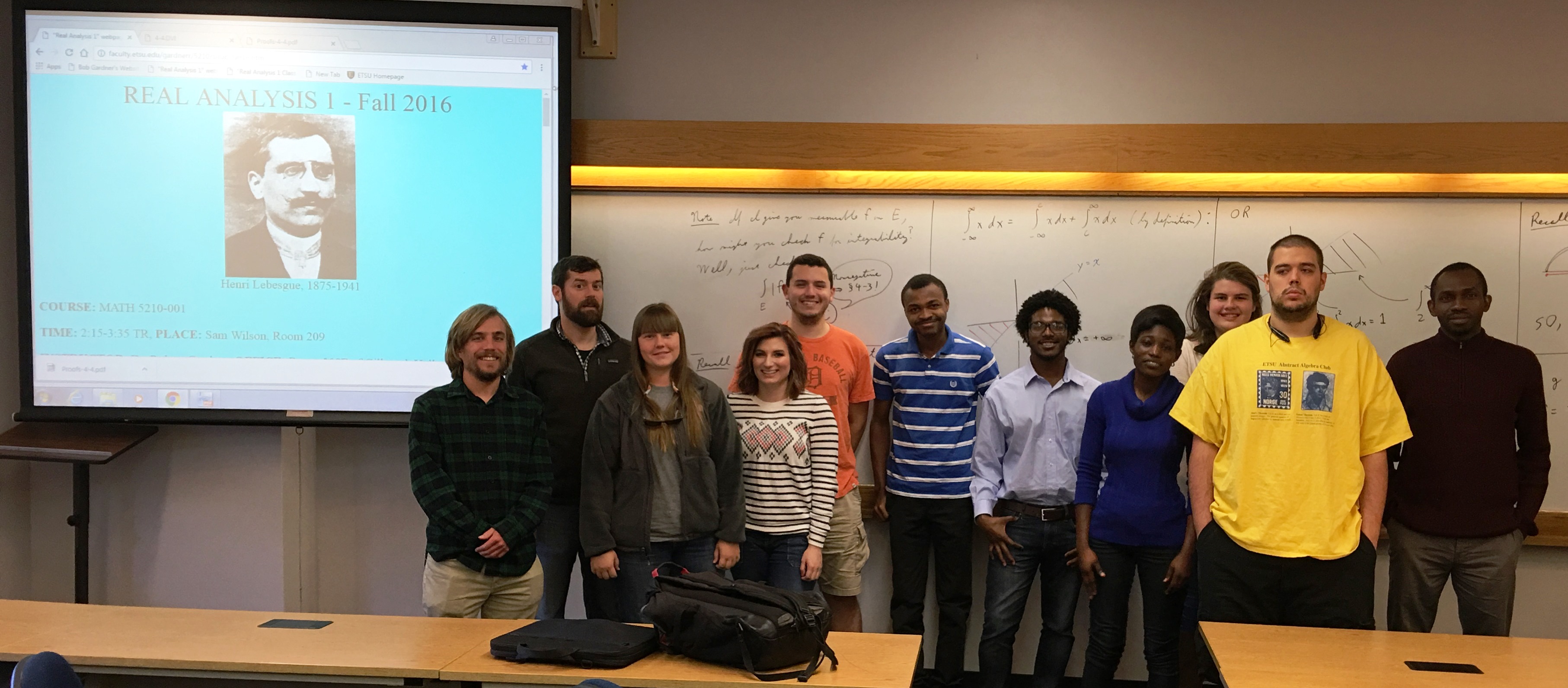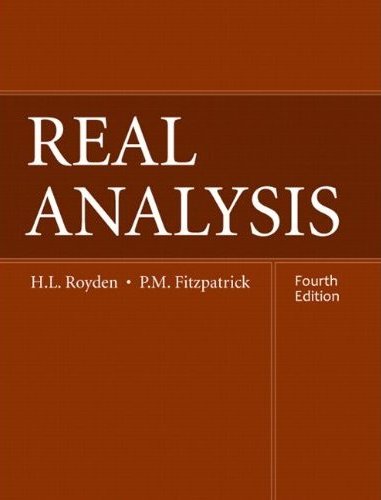
Henri Lebesgue, 1875-1941


COURSE: MATH 5210-001
TIME: 2:15-3:35 TR, PLACE: Sam Wilson, Room 209
INSTRUCTOR: Dr. Robert Gardner, OFFICE: Room 308F of Gilbreath Hall
OFFICE HOURS: TR after class PHONE: 439-6979 (Math Office 439-4349)
E-MAIL: gardnerr@etsu.edu
WEBPAGE: http://faculty.etsu.edu/gardnerr/gardner.htm
TEXT: Real Analysis, Fourth Edition, by H.L. Royden and P.M. Fitzpatrick, Prentice Hall (2010).

CLASS NOTES: We will use projected digital notes for the component of the lecture consisting of definitions, statements of theorems, and some examples. Proofs of the vast majority of theorems, propositions, lemmas, and corollaries are available and in Beamer presentations and will be presented in class as time permits. The white board will be used for marginal notes and additional examples and explanation. Copies of the notes are online at: http://faculty.etsu.edu/gardnerr/5210/notes1.htm. It is strongly recommended that you get printed copies of the overheads before the material is covered in class. This will save you from writing down most notes in class and you can concentrate on listening and supplementing the notes with comments which you find relevant. You should read the online notes to be covered in class before each class (we may not have class time to cover every little detail in the online notes). Try to understand the definitions, the examples, and the meanings of the theorems. After each class, you should read the section of the book covered in that class, paying particular attention to examples and proofs.
ABOUT THE COURSE: This class offers a standard introduction to the theory of functions of a real variable from the measure theoretic perspective. As commented on page 1 of the third edition of Real Analysis, we will cover "a portion of the material that every graduate student in mathematics must know." Whereas the undergraduate real analysis class presents the results of calculus from a rigorous perspective, we will introduce fundamentally new ideas which are basic extensions of the results from calculus. In particular, we will put a weight or "measure" on certain sets of real numbers. This measure will be used to define a new type of integral called the Lebesgue integral. Recall that a function is Riemann integrable if and only if it is discontinuous on a "small" set (namely, a set of measure zero). The Lebesgue integral is much more flexible and will allow us to integrate a much larger class of functions. In addition, we will have a number of "convergence theorems" related to the Lebesgue integral, which are not true in the setting of Riemann integration. The fourth edition of Real Analysis states on page x that "The general theory of measure and integration was born in the early twentieth century. It is now an indispensable ingredient in remarkably diverse areas of mathematics, including probability theory, partial differential equations, functional analysis, harmonic analysis, and dynamical systems. Indeed, it has become a unifying concept."
GRADING: We will have two tests (T1 and T2) and homework (HW) will be taken up a regular intervals (weekly). Your average will be computed as follows:
A NOTE ABOUT HOMEWORK: While I suspect that you may work with each other on the homework problems (in fact, I encourage you to), I expect that the work you turn in is your own and that you understand it. Several of the homework problems are fairly standard for this class, and you may find proofs online. However, the online proofs may not be done with the notation, definitions, and specific methods which we are developing and, therefore, are not acceptable for this class. Your homework grade will also reflect how clearly you write up your solution and document your claims.
TENTATIVE OUTLINE:
Essential Background for Real Analysis I
Real numbers, field, ordering, least upper bounds, completeness, Cauchy sequences, lim sup, lim inf, open, closed, compact, connected, Heine Borel Theorem, cardinality, countable/uncountable, Cantor's Theorem, Continuum Hypothesis.
The Riemann-Lebesgue Theorem
Riemann integral, measure zero set, oscillation, uniform convergence, convergence theorems.
Chapter 1: The Real Numbers (Section 4)
σ-algebras of sets, Borel sets, Fσ and Gδ sets.
Chapter 2: Lebesgue Measure
outer measure, measurable sets, inner approximation, Lebesgue measure, nonmeasurable set, Banach-Tarski Paradox, Cantor set and Cantor-Lebesgue Function.
Axiom of Choice: More Axiom of Choice and the Banach-Tarski Paradox.
Chapter 3: Lebesgue Measurable Functions
measurable functions, characteristic functions, approximation, Littlewood's principles, Egoroff's Theorem, Lusin's Theorem.
Chapter 4: Lebesgue Integration
Riemann integral, step functions, simple functions, Lebesgue integral of a
bounded function, Bounded Convergence Theorem, Fatou's Lemma, Monotone
Convergence Theorem, Lebesgue Dominated Convergence Theorem, general Lebesgue
integral, uniform integrability.
IMPORTANT DATES: (see http://www.etsu.edu/etsu/academicdates.aspx for the official ETSU calendar; accessed 11/22/2015):
| |
||||
3.1. Sums, Products, and Compositions |
3, 7 |
|||
Return to
Bob Gardner's home page
Last updated: November 30, 2016.